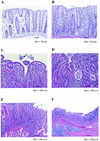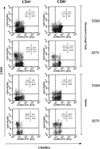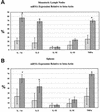Infectious agent and immune response characteristics of chronic enterocolitis in captive rhesus macaques
- PMID: 12819098
- PMCID: PMC162015
- DOI: 10.1128/IAI.71.7.4079-4086.2003
Infectious agent and immune response characteristics of chronic enterocolitis in captive rhesus macaques
Abstract
Chronic enterocolitis is the leading cause of morbidity in colonies of captive rhesus macaques (Macaca mulatta). This study's aim was to identify the common enteric pathogens frequently associated with chronic enterocolitis in normal, immunocompetent rhesus monkeys and to elucidate the influence of this clinical syndrome on the host immune system. We analyzed the fecal specimens from 100 rhesus macaques with or without clinical symptoms of chronic diarrhea. Retrospective analysis revealed an increased incidence of Campylobacter spp. (Campylobacter coli and Campylobacter jejuni), Shigella flexneri, Yersinia enterocolitica, adenovirus, and Strongyloides fulleborni in samples collected from animals with chronic diarrhea (P < 0.05). The presence of additional enteric pathogens, such as Escherichia coli, carrying the eaeA intimin or Stx2c Shiga toxin virulence genes, Balantidium coli, Giardia lamblia, Enterocytozoon bieneusi, and Trichuris trichiura was found in all animals regardless of whether diarrhea was present. In addition, the upregulation of interleukin-1 alpha (IL-1 alpha), IL-3, and tumor necrosis factor alpha cytokine genes, accompanied by an increased presence of activated (CD4(+) CD69(+)) T lymphocytes was found in gut-associated lymphoid tissues collected from animals with chronic enterocolitis and diarrhea in comparison with clinically healthy controls (P < 0.05). These data indicate that chronic enterocolitis and diarrhea are associated, in part, with a variety of enteric pathogens and highlight the importance of defining the microbiological status of nonhuman primates used for infectious disease studies. The data also suggest that chronic colitis in rhesus macaques may have potential as a model of inflammatory bowel disease in humans.
Figures




References
-
- Ash, L. R., and T. C. Orihel. 1987. Parasites: a guide to laboratory procedures and identification, p. 18-33. In L. R. Ash and T. C. Orihel (ed.), Parasites: a guide to laboratory procedures and identification. ASCP Press, Chicago, Ill.
-
- Baert, F. J., and P. R. Rutgeerts. 1999. Anti-TNF strategies in Crohn's disease: mechanisms, clinical effects, indications. Int. J. Colorectal Dis. 14:47-51. - PubMed
-
- Bell, S., and M. A. Kamm. 2000. Antibodies to TNF alpha as treatment for Crohn's disease. Lancet 355:858-860. - PubMed
-
- Bhan, A. K., E. Mizoguchi, R. N. Smith, and A. Mizoguchi. 2000. Spontaneous chronic colitis in TCR alpha-mutant mice; an experimental model of human ulcerative colitis. Int. Rev. Immunol. 19:123-138. - PubMed
Publication types
MeSH terms
Substances
Grants and funding
LinkOut - more resources
Full Text Sources
Research Materials
Miscellaneous

